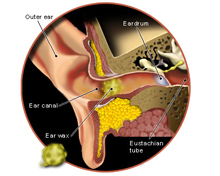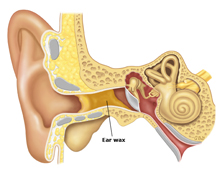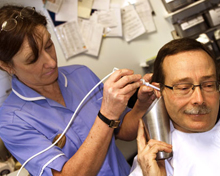Ear Wax Blockage is a Health Concern

Ear wax is general problem for every one. People sometimes ignore it and when there is trouble in listening, they visit doctor. It should not be taken lightly. Though it is not a serious problem but if cleanliness is not maintained, it can have dangerous effects.
The ears are made up of three different parts: the outer ear, also called the pinna. The middle ear is which is distinctly separated from the outer ear by the eardrum (sometimes called the tympanic membrane). The middle ear contains tiny bones which amplify sound waves. The inner ear is where most sound waves are translated into electrical impulses and conducted to the brain. The hair and secretory glands in the ear canal cleans itself with a waxy secretion called cerumen, most of the time.
Ear was has a defensive function in nature. The skin lining the outer ear canal contains glands which produce cerumen. The cerumen is a slighty yellowish - brown waxy substance. Earwax consists of dead, flattened cells on the outer layer of skin, a wax-like substance produced by sweat glands, sebum (an oily substance produced by sebaceous glands), and various other substances, such as cosmetics and dirt. In nature, its function is to shield the underlying tissues.
It also helps to prevent from infection by trapping micro-organisms, dirt and other irritants. Wax is constantly traveling towards the outer ear where it can drop out. Actions of the jaw, such as talking and chewing, assist to massage the wax out of the canal. The ear wax shed skin cells and dirt. The absence of ear wax may result in dry, itchy ears, and even infection. Cerumen may vary in form and appearance. It may be almost liquid, or firm and solid. The usage of ear phones and speakers obstructs with the smooth movement to the exterior. Therefore, the wax builds up because it is not able to get to the exterior, this may be due to the use of hearing aids or head phones.
The accumulation of wax, in the outer ear causes numerous
symptoms. These are mild deafness and/or a sensation of fullness
inside the ear. This condition is not dangerous and easily
treated most of the time. However, sometimes, a wax plugs forms
and may need intervention to loosen and aid its extraction. Ear
wax may cause mild to sever earache, a sensation of fullness
inside the ear, a constant ringing in the ear. This is often
called "Tinnitus". There may be loss of balance / dizziness.

Some individuals are more prone to ear wax blockages than others. The exact reasons are not clearly understood but it is established that some people produce more ear wax than others. According to statistics, patients with narrower ear canals are more likely to have problems.
People who have hairy ear canals, poor personal hygiene, overzealous cleaning with fingertips or cotton buds, which pushes wax further down the ear canals, working in dusty or dirty environments, inflammatory conditions of the skin or scalp are at greater risk of ear wax problems. It is advisable that person should not put anything smaller than elbow in ear. Wax is not formed in the deep part of the ear canal near the eardrum, but only in the outer part of the canal near the external opening.
So when a doctor examines that a patient has wax pushed up against the eardrum, he or she knows that it is often because the patient has been probing his or her ear with such things as Q-Tips, bobby pins or twisted napkin corners. Such objects only serve as ramrods to push the wax deeper into the ear. Also, the skin of the ear canal and the eardrum is very thin and fragile, and is easily injured. The ear canal is more prone to infection after it has been whipped clean of the good coating-type wax. Doctors see many perforated eardrums as a result of the above efforts.
Diagnosis is done by ENT specialists. There are no tests conducted to confirm the presence of earwax. However, if person have problems as a result of earwax, a specialist may examine both of ear canals using an instrument called an auriscope. They will be able to see if wax is present, and whether or not it appears to be impacted. If person have hearing loss, it may be the result of impacted earwax. It be detected using a number of tuning fork tests, such as Rinne test and Weber test
In Rinne test, doctor places a vibrating tuning fork at different points of patient's ear usually, the external auditory meatus (the entrance to the ear canal) and the mastoid bone (behind the ear lobe). Patient will be asked to say which one sounds the loudest so that the tester can determine whether he is more able to pick up sound via air conduction or bone conduction. In the Weber test, the vibrating tuning fork is placed on the middle of patient's forehead. The Weber test will facilitate the tester to determine whether hearing loss is sensorineural (sound loss through the air), conductive (sound loss through bone), or whether it is a combination of both. If there is a combination of both sensorineural and conductive hearing loss, the results of the tuning fork tests may be unreliable
A competent physician can diagnose the condition by examining into the ear canal. There are many treatment options. Some doctors recommend the use of two drops of mineral oil in each ear one day per week at bedtime to help liquefy ear wax in people who have a history of recurrent problems with ear wax. This should only be done if the individual has an intact eardrum and no other known problems with the ears. They can use an ear syringe to squeeze warm water into the ear canal and float out the wax plug.
This works because the wax is oily and floats on warm water. A comparatively new but high tech. method involves the use of a suction device to suck out the wax. Removing the wax with forceps or a special hook is often done in socio economically poor areas. If the ear is completely plugged and there are large quantities of hardened wax then the patient must immediately visit doctor for treatment.
 Numerous complications may occur as a result of impacted
earwax. These include infection, failure of earwax removal,
otitis externa (inflammation of the ear canal), otitis media
(inflammation of the middle ear caused by water entering when
there is a previous perforation), perforation of the tympanic
membrane (eardrum), damage to the external auditory meatus (tube
running from the outer ear to the middle ear), pain, and
vertigo. In some cases, light bleeding can occur but, if it
does, it usually stops on its own. Nausea, vomiting, and vertigo
may result from temperature variations of the irrigating fluid.
In rare cases, infection may progress to the base of the skull,
causing cranial paralysis, meningitis, and death. The elderly
and people who are diabetic, or have a weak immune system are
most commonly affected. Chronic tinnitus (noises in ear) can
occur following earwax removal after irrigation or ear
curettage.
Numerous complications may occur as a result of impacted
earwax. These include infection, failure of earwax removal,
otitis externa (inflammation of the ear canal), otitis media
(inflammation of the middle ear caused by water entering when
there is a previous perforation), perforation of the tympanic
membrane (eardrum), damage to the external auditory meatus (tube
running from the outer ear to the middle ear), pain, and
vertigo. In some cases, light bleeding can occur but, if it
does, it usually stops on its own. Nausea, vomiting, and vertigo
may result from temperature variations of the irrigating fluid.
In rare cases, infection may progress to the base of the skull,
causing cranial paralysis, meningitis, and death. The elderly
and people who are diabetic, or have a weak immune system are
most commonly affected. Chronic tinnitus (noises in ear) can
occur following earwax removal after irrigation or ear
curettage.
We all know that it is not possible to reduce the amount of ear wax that is produced by the patient's ear or to widen the patient's ear canals. However, there are ways to reduce the occurrence of wax build-up. It is considered careful to use wax-softening drops or oils twice a week. If person is using a brand product, it is best to follow the manufacturer's instructions. Many problems can be prevented by avoid cleaning the ear canals with cotton buds or fingertips. Always clean the outer ear with a moist towel only. Person must contact a specialist for any associated inflammatory or infective skin conditions.
Note: This information is just for knowledge of disease. If such type of medical condition develops, consult your doctor.
Articles on Health
- Laparoscopic Surgery Advantages
- Laparoscopic Surgery History
- Laparoscopic surgery Procedures
- Limitations of traditional laparoscopic surgery
- New technologies for advance laparoscopic surgery
- Non-Robotic Laparoscopic Surgery
- Robotic Laparoscopic Surgery
- Causes and remedy for dark circles in females

- Harmful impact of mobile phone on unborn baby

- Maternal health care tips

- Rheumatoid Arthritis is Most Widespread in Female
- Periodontal ailment during Pregnancy
- Anemia is prevalent in Women
- Effect of Cell phone tower radiation on human health

- Current health scenario india
- Government health policies india
- Medical facilities india
- Hospital infrastructure india
- Shortage of Medical Professionals in India
- Quality standards indian hospitals
- Indian states health statistics
- Medical expenses india
- Hospitals in Ahmedabad
- Hospitals in Bangalore
- Hospitals in Chennai
- Hospitals in Cochin
- Hospitals in Delhi
- Hospitals in Hyderabad
- Hospitals in Kolkata
- Hospitals in Mumbai
- Hospitals in Pune
- Hospitals in Coimbatore
- Hospitals in Kochi
- Orthopaedics Hospitals in India
- Diabetology Hospitals in India
- Cardiology Hospitals in India
- Infertility Hospitals in India
- Neurology Hospitals in India
- Paediatrics Hospitals in India
- Nephrology Hospitals in India
- Oncology Hospitals in India
- Antiaging foods to improve skin

- Tips for Maintaining healthy bones
- Guidelines for preventing heart disease
- Tips to reduce eye strain while working on computer
- Mental health problems among elderly people
- Health problem of piles

- Health advices for air travel

- Dealing with Allergies
- Tips for Eyes Care
- Care for Crystal Clear Skin
- Tips For Healthy Hair
- Healthy Living is The Absolute Measure of Happiness
- Let Fragrance Rule Your Summer
- Most common vestibular disorder

- Osteoporosis Risk Factors
- Dengue

- Endocrine disorder

- Causes of liver damage
- Dry eye syndrome
- Kidney Stones
- Conjunctivitis: Irritating eye disease
- Anxiety Disorder
- Causes of Brain Damage
- Hepititis B
- Knowledge of Osteoarthritis
- Mental Illness
- Back Pain
- Sugar Addiction
- Diet Control Plans
- General Motors Diet Plan
- No Carbohydrate Diet
- One day Diet Plans
- Seven day diet Plans
- Vegetarian Diet
- Food for Health
- Genetically Modified Foods
- Healing Effects Of Fruits
- Vegetables That Heal
- Healing Effects Of Spices and Herbs
- Test your Stress Level
- Mantras for Relaxation & Stress free life
- Take walk For a healthy body and mind
- Squint is frequently observed in Children
- Consult-Doctor
- Free Handy Health Advice